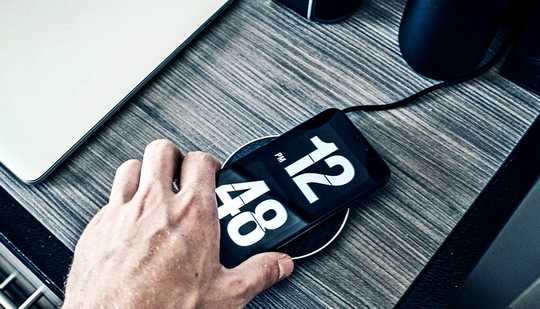
Wirelessly charging your phone, while highly convenient, risks depleting the life of devices using typical lithium-ion batteries (LIBs), report researchers.
Consumers and manufacturers have ramped up their interest in this convenient charging technology, called inductive charging, abandoning fiddling with plugs and cables in a favor of just setting the phone directly on a charging base.
Standardization of charging stations, and inclusion of inductive charging coils in many new smartphones has led to rapidly increasing adoption of the technology. In 2017, 15 automobile models announced the inclusion of consoles within vehicles for inductively charging consumer electronic devices, such as smartphones—and at a much larger scale, many are considering it for charging electric vehicle batteries.
Issues with wireless charging
Inductive charging enables a power source to transmit energy across an air gap, without the use of connecting wire but one of the main issues with this mode of charging is the amount of unwanted and potentially damaging heat it can generate.
There are several sources of heat generation associated with any inductive charging system—in both the charger and the device its charging. the fact that the device and the charging base are in close physical contact makes this additional heating worse. Simple thermal conduction and convection can transfer any heat generated in one device to the other.
In a smartphone, the power receiving coil is close to the back cover of the phone (which is usually electrically non-conductive) and packaging constraints necessitate placement of the phone’s battery and power electronics in close proximity, with limited opportunities to dissipate heat generated in the phone, or shield the phone from heat the charger generates.
It has been well-documented that batteries age more quickly when stored at elevated temperatures and that exposure to higher temperatures can thus significantly influence the state-of-health (SoH) of batteries over their useful lifetime.
The rule of thumb (or more technically the Arrhenuis equation) is that for most chemical reactions, the reaction rate doubles with each 10 °C (18 °F) rise in temperature. In a battery, the reactions which can occur include the accelerated growth rate of passivating films (a thin inert coating making the surface underneath unreactive) on the cell’s electrodes. This occurs by way of cell redox reactions, which irreversibly increase the internal resistance of the cell, ultimately resulting in performance degradation and failure. A lithium ion battery dwelling above 30 °C (86 °F) is typically considered to be at elevated temperature exposing the battery to risk of a shortened useful life.
Guidelines battery manufacturers have issued also specify that the upper operational temperature range of their products should not surpass the 50?60 °C (122?140 °F) range to avoid gas generation and catastrophic failure.
These facts led the researchers to carry out experiments comparing the temperature rises in normal battery charging by wire with inductive charging. However the researchers were even more interested in inductive charging when the consumer misaligns the phone on the charging base. To compensate for poor alignment of the phone and the charger, inductive charging systems typically increase the transmitter power and/or adjust their operating frequency, which incurs further efficiency losses and increases heat generation.
This misalignment can be a very common occurrence as the actual position of the receiving antenna in the phone is not always intuitive or obvious to the consumer using the phone. The research team therefore also tested phone charging with deliberate misalignment of transmitter and receiver coils.
Comparing charging methods
The researchers tested all three charging methods (wire, aligned inductive, and misaligned inductive) with simultaneous charging and thermal imaging over time to generate temperature maps to help quantify the heating effects.
In the case of the phone charged with conventional mains power, the maximum average temperature reached within 3 hours of charging did not exceed 27 °C (80.6 °F).
In contrast, for the phone charged by aligned inductive charging, the temperature peaked at 30.5 °C (86.9 °F) but gradually reduced for the latter half of the charging period. This is similar to the maximum average temperature observed during misaligned inductive charging.
In the case of misaligned inductive charging, the peak temperature was of similar magnitude (30.5 °C (86.9 °F)) but this temperature was reached sooner and persisted for much longer at this level (125 minutes versus 55 minutes for properly aligned charging).
Regardless of the mode of charging, the right edge of the phone showed a higher rate of increase in temperature than other areas of the phone and remained higher throughout the charging process. A CT scan of the phone showed that this hotspot is where the motherboard is located.
Also noteworthy was the fact that the maximum input power to the charging base was greater in the test where the phone was misaligned (11 watts) than the well-aligned phone (i watts). This is due to the charging system increasing the transmitter power under misalignment in order to maintain target input power to the device.
The maximum average temperature of the charging base while charging under misalignment reached 35.3 °C (95.54 °F), two degrees higher than the temperature researchers detected when the phone was aligned, which achieved 33 °C (91.4 °F). This is symptomatic of deterioration in system efficiency, with additional heat generation attributable to power electronics losses and eddy currents.
The researchers note that future approaches to inductive charging design can diminish these transfer losses, and thus reduce heating, by using ultrathin coils, higher frequencies, and optimized drive electronics to provide chargers and receivers that are compact and more efficient and can be integrated into mobile devices or batteries with minimal change.
In conclusion, the research team found that inductive charging, while convenient, will likely lead to a reduction in the life of the mobile phone battery. For many users, this degradation may be an acceptable price for the convenience of charging, but for those wishing to eke out the longest life from their phone, cable charging is still recommended.
Source: University of Warwick
























